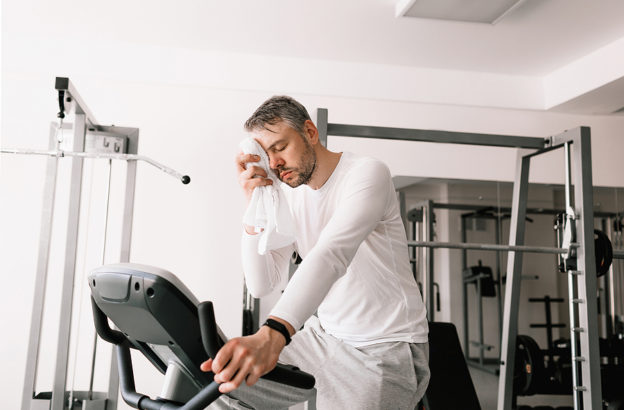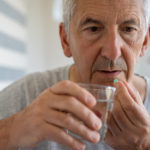By David Blyweiss, M.D., Advanced Natural Wellness
June 7, 2021
Mitochondria. They power every cell in your body with energy.
And your muscles require a lot of energy, so mitochondria are found in abundance in muscle cells.
They give your muscles the strength and endurance they need to perform daily activities. At the same time, the more activity you get, the more mitochondria you generate.
But there’s actually a fine line between too much activity… and not enough.
Let’s say you get very little activity. Then you decide to take up an exercise program. The first time you get out and get moving, your body will generate a stress response that actually signals the body to make more mitochondria. It’s called mitochondrial biogenesis.
Now this is great. It means we can stave off the age-related decline in the quantity and quality of our mitochondria. And it doesn’t take long to do it.
MD Exposes the Hidden Danger to Your Eyes

When your eyesight starts to fail, it's a real problem. Suddenly you can't go to the grocery store... you can't get to the doctor if you have an emergency... you can't meet your friends for dinner…
Your "regular" doctor doesn't have time to keep up with the latest research. And the same goes for eye doctors. They go to school to learn how to fit you for glasses and contacts, but have no way of preventing the damage and loss of eyesight that threatens your freedom and independence.
Let me show you something that explains a LOT about how your eyes work.
In my FREE Special Report, I'll show you a HUGE, untapped resource for your eyes that safely and naturally restores clear, effortless eyesight.
Click here to get started...
The Mayo Clinic discovered that just 12 weeks of high intensity interval training (HIIT) increased mitochondrial energy production in young adults by 49%. And the increase in older adults – between the ages of 65 and 80 – was a dramatic 69%.
What did the people do to make these gains? They rode a bicycle three days a week. They pedaled at full speed for four minutes, then took a two-minute break before pedaling full speed for three minutes. After that they took another two-minute break followed by four minutes of full speed pedaling.
That’s just 15 minutes of bicycling, three days a week for massive mitochondrial support.
Too Much of a Good Thing
Now, if 15 minutes a few days a week is good for you, more would probably be better, right?
Not so fast.
Just like anything else, too much of a good thing can be bad for you.
Getting over 90 minutes of vigorous physical activity each week could actually reduce your mitochondrial function by as much as 40%.
Overdoing it on the exercise can damage muscles. This, in turn, produces inflammation and oxidative stress which are known factors when it comes to mitochondrial dysfunction.
Too much intense exercise can also lead to glucose intolerance and damage to the heart muscle.
The World's Quickest Solution for Ending Prostate and Urinary Misery
This has recently been revealed to be one of the only real breakthroughs in prostate health.
The seeds of a strange fruit (sometimes called "Chinese Apples") hold powerful phytonutrients that are a revolution in prostate health.
In fact, UCLA and Veterans Administration research have now proved this to be true.
Not only that, but it may be the worlds quickest solution for ending prostate misery.
Simply stated, these phytonutrients represent a huge step beyond beta sitosterol, saw palmetto, and other phytosterols alone.
Simply click HERE if you want to have fast prostate relief...restful, uninterrupted sleep...no more constant "urges to go"...enhanced virility...and optimal prostate support for life.
The key, then, is to get your physical activity in without causing excess damage or stress in your muscles.
The Perfect Amount of Exercise for Your Mitochondria
If you want to protect your mitochondria and live a long and active life, I personally recommend high-intensity-interval training, or HIIT. It only takes 15 minutes a day and is extremely effective.
The basic concept is to start out with short bursts of intense activity followed by a minute or two of rest or reduced activity levels. Then, as you progress to better health and stamina, you increase intensity and repetitions while at the same time taking shorter recovery periods.
Here’s a sample 6-day workout to get you started (the 7th day is for rest):
Days one, three and five: After warming up for a few minutes, do a 30-second sprint—walking or running as fast as you can. (I recommend brisk walking if you’re someone who is new to exercise or has never run on a consistent basis.) Then, follow it up with two to four minutes of easy walking. Repeat four to six times. The workout ends with a three-to-four-minute cool-down. The same concept would apply to bicycling.
As it becomes easier, try increasing the intensity of the sprint and shortening your recovery time. (i.e., a 30 second full-out burst, followed by lesser and lesser minutes of easy walking.)
Days two, four and six: Choose two or three different resistance exercises that suit your physical level. Almost anyone can perform planks, bridges and chair dips. More difficult resistance exercises include squats, lunges and pushups.
Then, simply perform one exercise for 30 seconds. Take a short break then move onto the next exercise and do it for 30 seconds. After a final break, move on to the final exercise. Once complete, repeat the set three more times.
For patients who have been sedentary and are just starting a new fitness routine, I often recommend low-intensity-interval training, or LIIT.
It’s similar to HIIT, but much less intense.
For example, in a LIIT scenario a jog/sprint would be scaled back to a walk/jog… or even a walk/fast-walk. Instead of two-minute rest or recovery periods, they might stretch out to four or five minutes.
There’s no doubt that the right amount of physical activity is good for you. But there is a fine line between too much of it… and not enough. That’s why I suggest a good variety of movement interspersed with intensity.
And as always, check with your doctor before starting a new exercise program.
SOURCES:
Robinson MM, Dasari S, Konopka AR, et al. Enhanced Protein Translation Underlies Improved Metabolic and Physical Adaptations to Different Exercise Training Modes in Young and Old Humans. Cell Metab. 2017;25(3):581-592.
Flockhart M, Nilsson LC, Tais S, et al. Excessive exercise training causes mitochondrial functional impairment and decreases glucose tolerance in healthy volunteers. Cell Metabolism. 2021 May;33(5):957-970.e6.
Patergnani S, Bouhamida E, Leo S, Pinton P, Rimessi A. Mitochondrial Oxidative Stress and “Mito-Inflammation”: Actors in the Diseases. Biomedicines. 2021 Feb 20;9(2):216.
Stewart GM, Chan J, Yamada A, Kavanagh JJ, Haseler LJ, Shiino K, Sabapathy S. Impact of high-intensity endurance exercise on regional left and right ventricular myocardial mechanics. Eur Heart J Cardiovasc Imaging. 2017 Jun 1;18(6):688-696.
Patil HR, O’Keefe JH, Lavie CJ, Magalski A, Vogel RA, McCullough PA. Cardiovascular damage resulting from chronic excessive endurance exercise. Mo Med. 2012 Jul-Aug;109(4):312-21. Erratum in: Mo Med. 2014 Mar-Apr;111(2):135.






